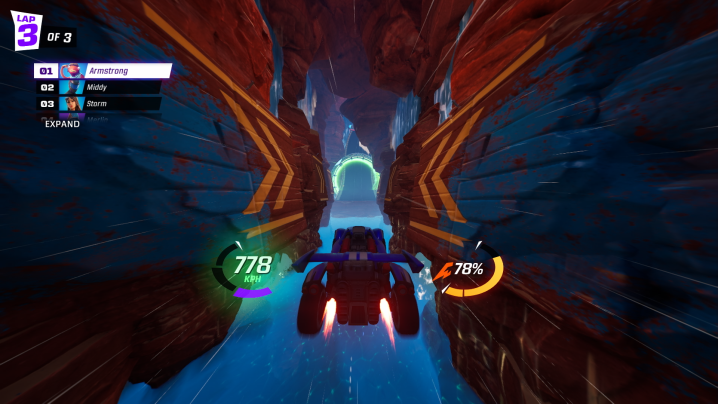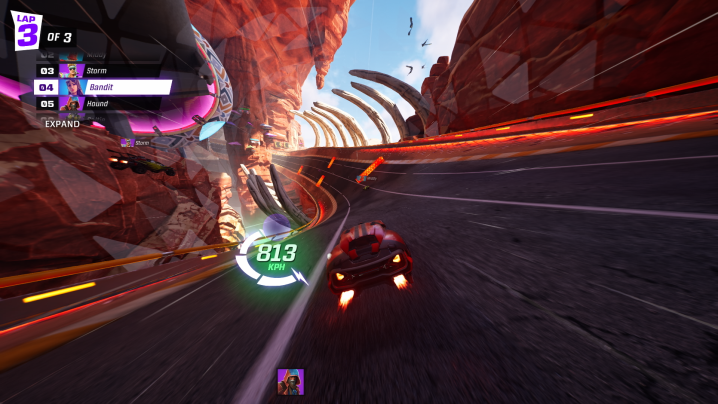
Yesterday, Fortnite began its biggest expansion yet by dropping Lego Fortnite, a full survival crafting game that’s playable for free within Fortnite. It was a pleasant surprise, but it isn’t the best piece of new content coming to the live-service juggernaut this week. That honor goes to Rocket Racing, an arcade racing game from the developers of Rocket League that’s available in Fortnite today.
This isn’t a simple kart racer that anyone could have put together in Fortnite’s creative mode. It’s a full-throated, free-to-play game that features 26 tracks at launch and some surprisingly deep driving systems. While Lego Fortnite may have had trouble standing on its own two feet outside of the Fortnite client, Rocket Racing could very well have launched as its own game — and it still would be the best racing game of its type this year.
I got a taste of Rocket Racing ahead of launch, trying out five of its tracks. Though I initially figured it would be a novelty, I’m now expecting I’ll be loading up Fortnite more for races than for battle royale shootouts. It’s the kind of top-notch, all-ages racer that developer Psyonix was always destined to make.
A turbo boost for Fortnite
Rocket Racing essentially turns Psyonix’s car-soccer game Rocket League into a traditional arcade racer. Up to 12 cars race at once on tracks that have alternate paths, secrets, and boost pads. There aren’t items like in Mario Kart; rather, it’s a pure test of speed that has players managing boosts gained by strategic drifting. At first glance, it doesn’t seem terribly deep, but that quickly changes when rolling onto its more complex tracks.
There are several little nuances that make Rocket Racing stand out among its flashier peers. For starters, every car has a passive drift that kicks in when taking turns. Players don’t have to press a button to pull that off, though holding a button will allow players to perform extra tight drifts. The more players drift, the more boost energy is stored up in a three-tick gauge. When one is full, players can tap a button to zip forward. Completing a quick button timing minigame during the boost will grant an additional burst of speed. The satisfying secret to success in each race comes down to how well players can manage their boosts, storing them for the right moment and strategically turning to build them back up.

Each of the five races I played was a tense test of control and speed as a result. I was neck and neck with my opponents the entire time, sticking close behind them to get an extra jolt of speed and strategically boosting at the right moment so they couldn’t pull the same trick on me when I got ahead. One race ended in a photo finish that had my opponent beating me to second place by mere milliseconds. It’s fast and competitive racing, but also easy enough to control that I imagine young players won’t have trouble keeping up.
Also unique to Rocket Racing is its emphasis on jumping and gliding. Like Rocket League, players can hop in the air and briefly jet around until a jump gauge depletes. Cars can even attach to walls, letting players drive sideways on some tracks. Psyonix has a lot of fun bringing that idea to an arcade racer, building multilevel tracks that split up the action. On one track, I race into a tunnel while some of my opponents jump on top of it and zip by above my head. That makes for some surprising outcomes, as you can never get too confident when you’re in first. Just because you can’t see other drivers doesn’t mean you’ve outraced them.
Rocket Racing really started to sing when I began chaining all of those techniques together. I could fluidly drift around a wide corner, launch into the air to glide over to a high-rise platform, and launch a boost to zip ahead of the pack. I had enough space to experiment on a few tracks too, trying my luck with secret paths hidden behind waterfalls or jumping off course to hit a boost pad. No track I played was too complex, but I imagine there are some additional tricks in the 20-something courses I’ve yet to try.
Fortnite is turning into an all-in-one platform where the publisher’s studios can create top-of-the-line games within the app.
And that’s only the beginning. Rocket Racing will utilize a seasonal structure that’ll bring more content to the game over time, just as a standalone release would. It’s strongly integrated into Fortnite’s wider ecosystem too. Cars will begin appearing inFortnite’s standard battle pass, which can be used in both the racing game and battle royale mode. As a cherry on top, any car bought in Rocket Racing can be used in Rocket League — and vice versa.
It’s that last part that really sells what Epic Games is building right now. Fortnite is turning into an all-in-one platform where the publisher’s studios can create top-of-the-line games within the app. Those titles will share progression with Fortnite, and even games outside of it, building toward a reality where very different experiences coexist. Rocket Racing is the best proof of concept you could ask for, delivering airtight arcade racing from one of Epic’s best studios. If Fortnite can keep delivering high-quality work like this, I’ll never uninstall it.
Rocket Racing is available in Fortnite now for free.



